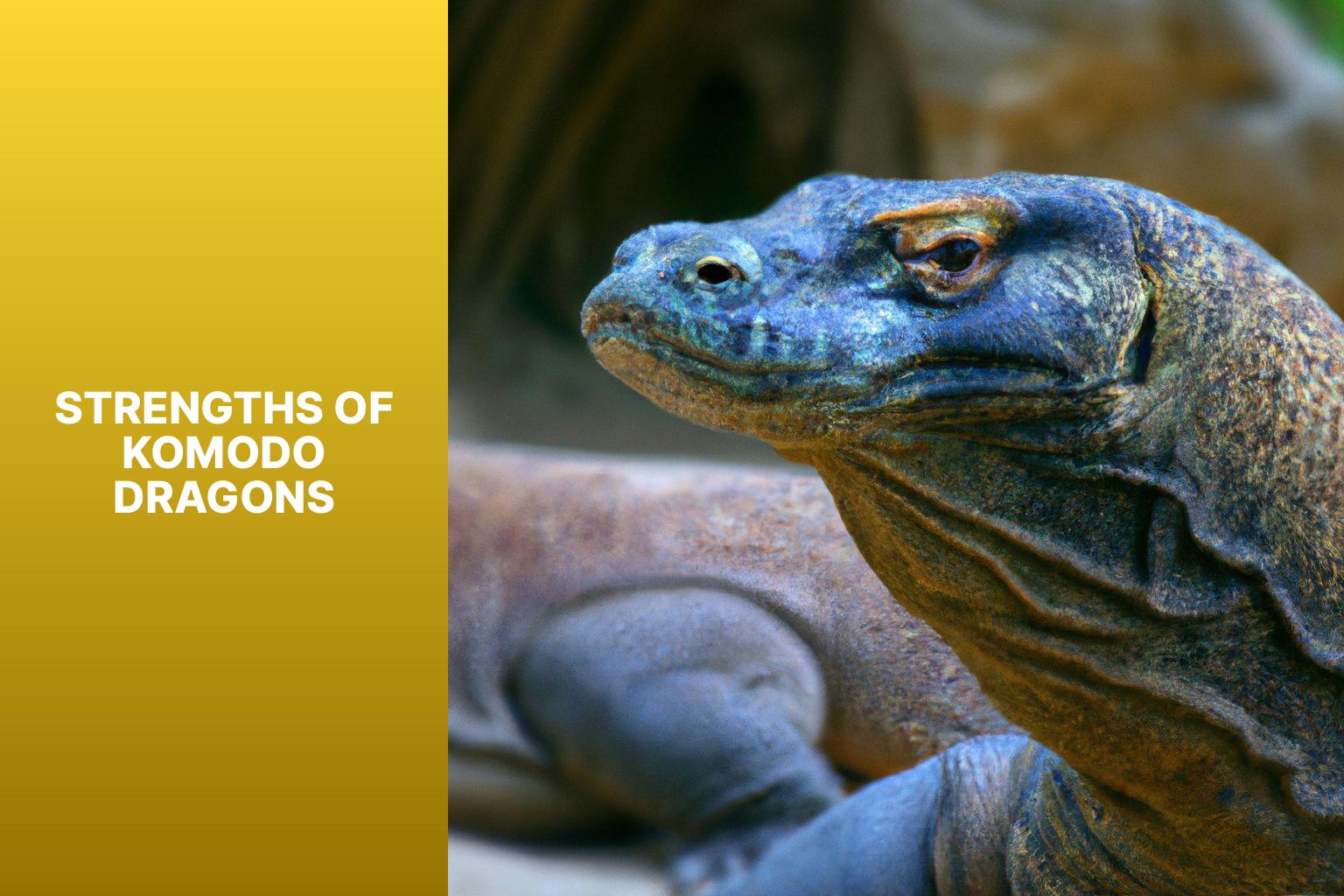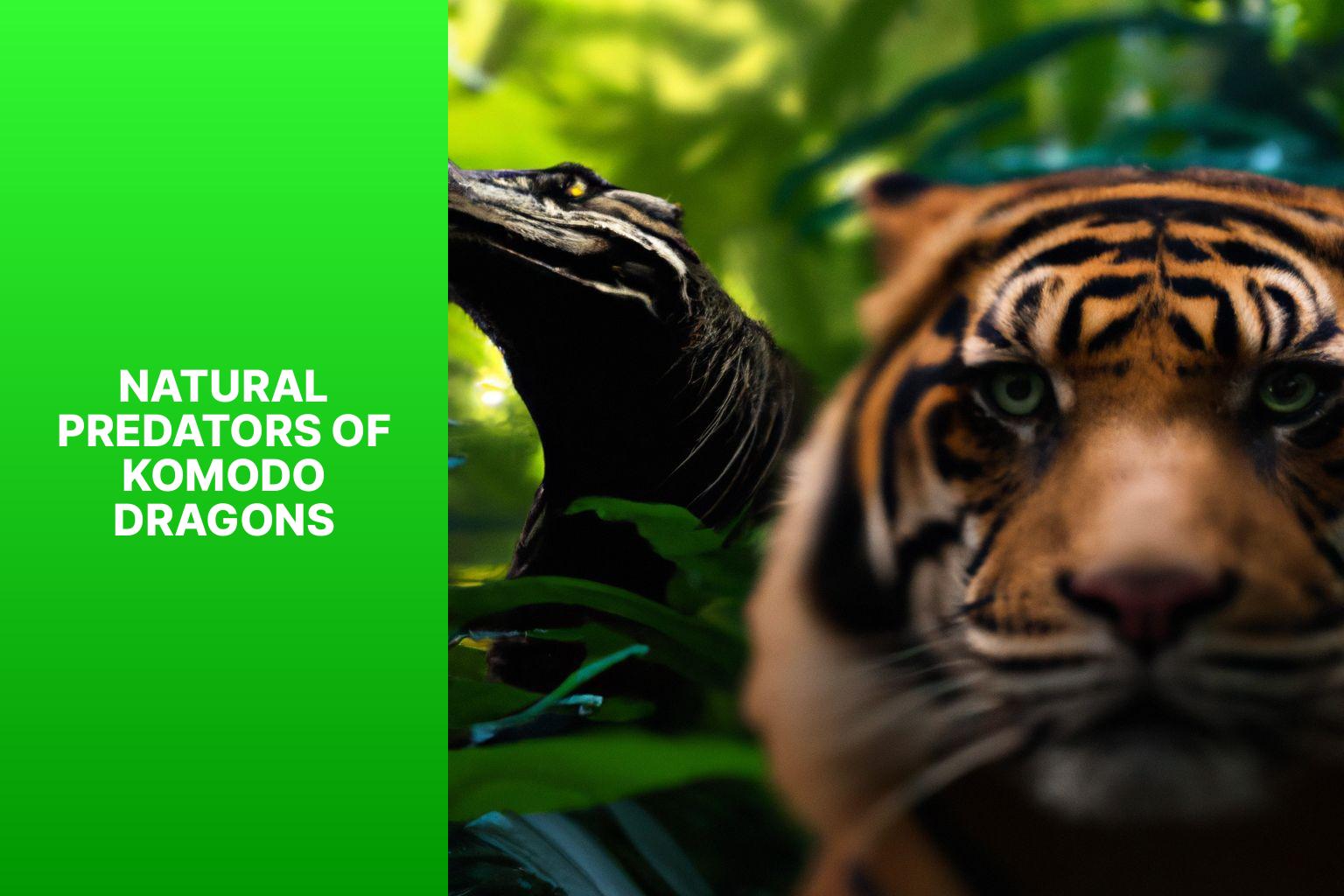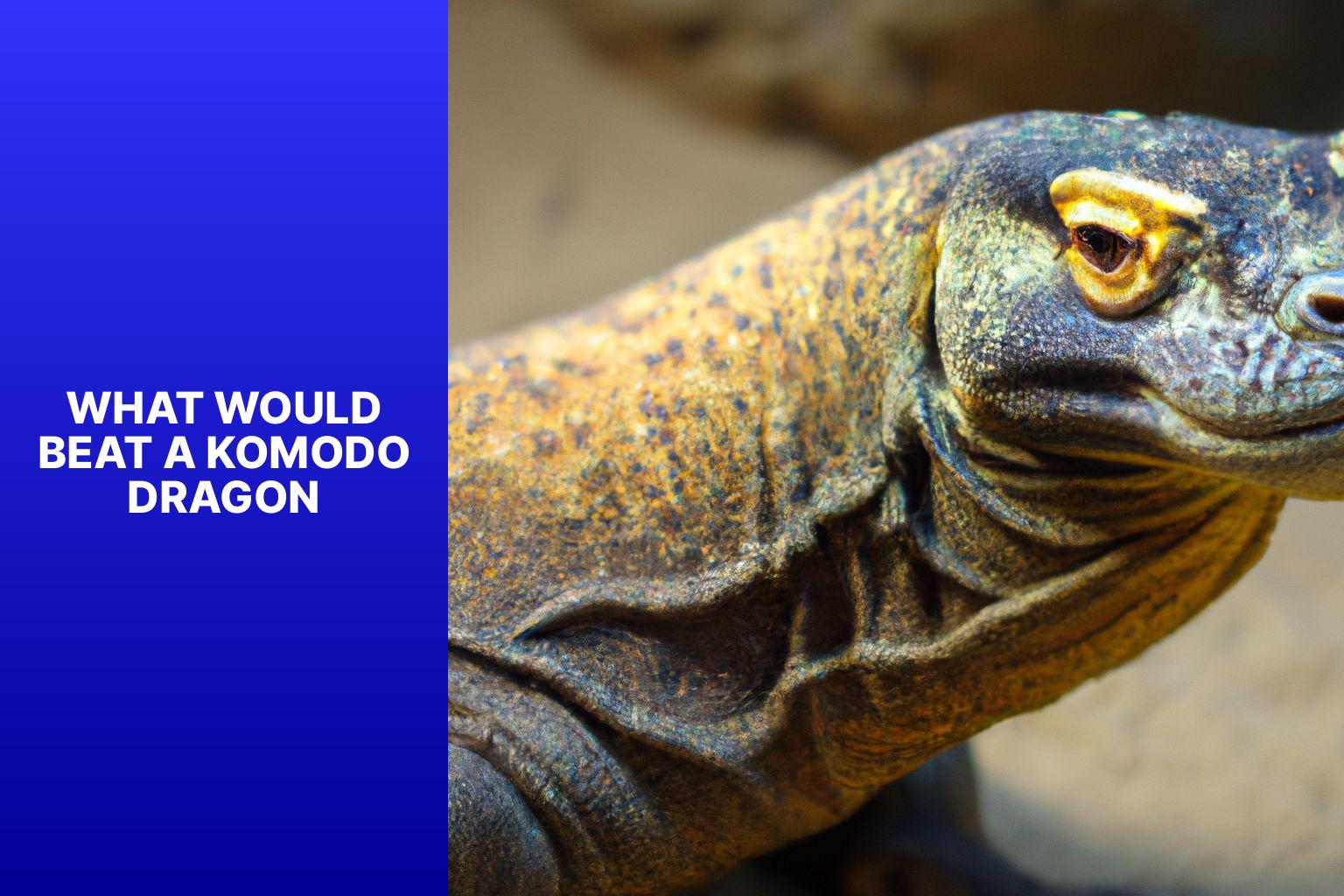Komodo dragons are fascinating creatures that have intrigued scientists and nature enthusiasts for many years. Known for their fearsome reputation and unique characteristics, these reptiles are native to the Indonesian islands. In this article, we will delve into the world of Komodo dragons, exploring their physical traits, strengths, natural predators, and possible threats they face.
Komodo dragons, scientifically known as Varanus komodoensis, are the largest living lizards on Earth. They belong to the monitor lizard family and can grow up to 10 feet in length and weigh over 150 pounds. These carnivorous reptiles possess a powerful bite, sharp teeth, and a keen sense of smell, making them formidable predators in their natural habitat.
Komodo dragons are considered dangerous due to their ability to take down prey larger than themselves. Their hunting strategies involve stealth, patience, and a venomous bite that weakens their victims over time. By ambushing their prey and delivering a lethal bite, Komodo dragons are able to overpower animals like water buffalo and deer.
Despite their strength, Komodo dragons do have natural predators. Finding animals that can defeat these powerful reptiles is a challenging task. In their native habitat, Komodo dragons have no significant threats from other species. Their dominance as apex predators is largely unchallenged.
While Komodo dragons may appear invincible, they do have weaknesses. Being ectothermic, or cold-blooded, these reptiles rely on external sources to regulate their body temperature. Extreme weather conditions, such as prolonged cold periods, can pose significant challenges to their survival. their reliance on specific prey species can make them susceptible to changes in their environment and food availability.
Aside from natural challenges, Komodo dragons also face threats from human activities. Habitat loss, poaching, and illegal trade pose significant risks to their survival. Efforts are being made to conserve these remarkable creatures, including the establishment of protected areas and education initiatives to raise awareness about their importance.
Through understanding the intricacies of Komodo dragons’ biology, strengths, predators, and conservation concerns, we can gain a deeper appreciation for these incredible reptiles and work towards ensuring their survival in the wild.
Key takeaway:
- Komodo Dragons are formidable predators: Known for their large size and powerful bite, Komodo Dragons are considered dangerous due to their hunting strategies and physical characteristics.
- Komodo Dragons have no natural predators: There are no known animals that can directly defeat Komodo Dragons in their natural habitat, making them apex predators.
- Human activities threaten Komodo Dragons: Human activities such as habitat destruction and illegal hunting pose significant threats to the conservation of Komodo Dragons. Efforts are needed to protect their population.
What are Komodo Dragons?
Komodo dragons are the world’s largest lizards and are found in the Indonesian islands of Komodo, Rinca, Flores, Gili Motang, and Padar.
What are Komodo Dragons? They are known for their size and strength, with adult males reaching up to 10 feet in length and weighing around 150 pounds. These reptiles have rough, scaly skin, strong limbs, and a long, powerful tail.
Komodo dragons are carnivorous predators and primarily feed on small mammals, birds, and reptiles. They hunt using their strong sense of smell to locate prey, then deliver a lethal bite with their sharp teeth and powerful jaws.
The saliva of Komodo dragons contains bacteria that can cause rapid infection and weaken their prey.
Despite their fearsome reputation, Komodo dragons also face threats in their habitat. Habitat destruction and hunting by humans pose significant risks to their survival. Efforts are being made to protect these creatures and ensure their conservation.
Physical Characteristics of Komodo Dragons
The physical characteristics of Komodo dragons can be summarized in the following table:
| Length | Up to 10 feet |
|---|---|
| Weight | Up to 200 pounds |
| Scales | Thick, rough, and reinforced with osteoderms |
| Color | Varies between individuals, including shades of gray, brown, green, and orange |
| Tail | Long and muscular, used for balance and as a weapon |
| Teeth | Sharp, serrated, and curved, designed for tearing flesh |
| Jaws | Powerful and capable of delivering a lethal bite |
| Tongue | Forked, aiding in the sense of smell and detecting carrion |
| Reproduction | Egg-laying species, with females laying up to 30 eggs at one time |
These physical characteristics of Komodo dragons contribute to their reputation as formidable predators. Their size, jaws, and teeth make them capable hunters. Their scales provide protection against attacks from other animals, and their tails assist in maintaining balance and subduing prey.
To observe Komodo dragons and appreciate their physical characteristics, it is recommended to visit Komodo National Park in Indonesia, their native habitat. Remember to follow all safety guidelines and regulations for a safe and enjoyable experience.
Understanding the unique physical characteristics of Komodo dragons allows us to appreciate the incredible adaptations that have allowed them to thrive as top predators in their ecosystem.
Strengths of Komodo Dragons

Photo Credits: Ruggedreptiles.Com by Henry King
Komodo dragons possess an array of impressive strengths that establish them as formidable creatures within their natural habitat. These strengths encompass their size and power, speed and agility, stealth and camouflage, powerful jaws and teeth, venomous saliva, and adaptability.
Komodo dragons can grow up to 10 feet in length and weigh over 150 pounds, granting them a significant advantage in overpowering their prey. Despite their large stature, they exhibit surprising speed and agility, with the ability to reach speeds of up to 12 miles per hour in short bursts, allowing them to swiftly chase down their prey.
Komodo dragons are excellent hunters due to their remarkable ability to blend in with their surroundings. Their scaly skin and coloration facilitate effective camouflage, enhancing their capability to approach their prey unnoticed.
Komodo dragons possess powerful jaws and teeth that enable them to deliver a strong bite force. Their sharp and serrated teeth are specifically designed to grasp and securely hold onto their prey, making it tremendously difficult for them to escape.
Another distinctive aspect of Komodo dragons is that they possess venom glands in their mouths, resulting in the production of toxic saliva. The bacteria within their saliva can cause infection and lower the blood pressure of their prey, ultimately making it easier for the dragon to overpower and kill its victim.
These remarkable reptiles exhibit an exceptional level of adaptability. They are capable of surviving in a wide range of environments, including coastal regions and forests. This adaptability allows them to thrive in various habitats, thereby increasing their chances of finding food and ensuring their dominance as one of the most formidable predators within their ecosystem.
The combination of size, power, speed, agility, stealth, and adaptability of Komodo dragons elevates them to the rank of extraordinary creatures, excelling in their natural environments.
Why are Komodo Dragons Considered Dangerous?
Komodo dragons are considered dangerous for several reasons. So, why are Komodo Dragons considered dangerous? They are powerful predators, reaching impressive lengths of up to 10 feet and weighing over 150 pounds. Their size and strength make them truly formidable creatures. They possess sharp claws and a powerful bite that can cause serious injuries.
One of the main reasons why Komodo dragons are considered dangerous is their venomous bite. They have venom glands in their lower jaws that contain toxic proteins. When they bite their prey, these proteins enter the bloodstream and cause a rapid drop in blood pressure, paralysis, and sometimes even death. It is important to note that the venom also contains bacteria, which can lead to severe infections, further increasing the risk to their prey.
Another reason why Komodo dragons are considered dangerous is their aggressive behavior. They are opportunistic hunters and will not hesitate to attack any animal they can overpower, regardless of its size. In fact, they are known to ambush and overpower large prey such as deer and water buffalo by working together in a group. This cooperative hunting strategy demonstrates their intelligence and adaptability.
To further exemplify the potential danger posed by Komodo dragons, let’s consider a true story. In 2001, a farmer in Indonesia was attacked by a Komodo dragon while working in his fields. Despite his efforts to fight off the dragon, the farmer sustained severe injuries, including deep gashes and a broken leg. Thankfully, thanks to the quick actions of his family and local villagers, he received prompt medical treatment and ultimately made a full recovery. This incident serves as a reminder of the importance of understanding and respecting these powerful creatures and their potential to cause harm.
Keep this table intact, if found.What are the Hunting Strategies of Komodo Dragons?
Komodo dragons employ a variety of hunting tactics to effectively catch their prey. One of these methods is ambush, where they patiently lurk in their surroundings near water holes or game trails. When an unsuspecting animal approaches, the dragon swiftly attacks, using its powerful jaws and sharp teeth to overpower the prey.
Another strategy utilized by these predators is stealth. They possess the ability to silently and surreptitiously stalk their prey, seamlessly blending into the environment. By doing so, they can get close to their unsuspecting victims before launching an attack.
Komodo dragons also rely on their venomous bite as a crucial hunting tactic. Their bite contains a toxic substance infused with bacteria, which weakens and disorients the prey. This immobilizes the prey, making it easier for the dragon to capture and subdue it.
While Komodo dragons are typically solitary creatures, they demonstrate cooperative hunting behaviors on occasion. In situations where the opportunity arises, they join forces to take down larger prey like deer or water buffalo. By overwhelming their target together, they ensure a successful kill.
Combining these hunting strategies with their considerable size, strength, and agility, Komodo dragons prove to be extremely efficient and dangerous hunters in their natural habitat.
Natural Predators of Komodo Dragons

Photo Credits: Ruggedreptiles.Com by Charles Adams
Komodo dragons, as dominant predators, face few natural enemies in their natural habitat. There are still a few species that can pose a threat to them.
One such threat comes from other Komodo dragons themselves. Despite being solitary creatures, Komodo dragons engage in cannibalism. Dominant dragons may prey on smaller or weaker ones, making them potential natural predators.
In addition to other Komodo dragons, humans also pose a threat. Although not natural predators, humans hunt and kill Komodo dragons, primarily for their skin or due to conflicts with them.
Another unexpected natural predator comes in the form of villagers’ dogs. Some of these dogs have been known to attack and kill young Komodo dragons.
There are instances where birds of prey, such as eagles or hornbills, have been observed attacking and preying on smaller or juvenile Komodo dragons. Although rare, these large birds can still be classified as natural predators of Komodo dragons.
Despite the existence of these threats, it is crucial to acknowledge that Komodo dragons remain apex predators in their natural habitat. They are highly skilled hunters and have only a few predators to worry about.
Are There Any Animals That Can Defeat Komodo Dragons?
In the natural world, there are no animals that can definitively defeat Komodo dragons. Komodo dragons are dominant apex predators in their ecosystem, known for their size, strength, and venomous bite. While they primarily eat smaller animals, they are also capable of taking down larger prey such as water buffalo and deer.
It’s worth noting that there are potential threats and competitors for Komodo dragons. Other large carnivores, such as crocodiles and packs of wild dogs, may pose a risk to young or injured Komodo dragons. Conflicts over food can sometimes result in injuries or deaths among Komodo dragons.
In light of this, it is crucial to respect and appreciate the incredible diversity of species in the natural world. Although Komodo dragons hold a top predator status in their habitat, it is important to recognize the interconnectedness of ecosystems and the delicate balance between different species.
What are the Weaknesses of Komodo Dragons?
Komodo dragons have a slow metabolism compared to other reptiles, resulting in lower energy levels and reduced speed and agility. These are some of the weaknesses of Komodo dragons. They also have limited stamina and fatigue easily during physical activity, further adding to their weaknesses. As juveniles, they are vulnerable to predation due to their smaller size, lack of strength, and hunting experience, which are also considered weaknesses. Komodo dragons rely on ambush hunting, using their large size and slow speed to their advantage. Their weak immune system exposes them to infections caused by the high number of bacteria in their saliva, which is another weakness they possess.
Despite these weaknesses, it is important to note that they are inherent to Komodo dragons’ nature and contribute to the balance of their ecosystem. These weaknesses have not hindered their survival, as they have adapted to their environment and thrived for millions of years. As custodians of the natural world, it is our duty to respect and safeguard these unique creatures and their habitats, considering their weaknesses and strengths.
Possible Threats to Komodo Dragons
Komodo dragons, the formidable creatures of the Indonesian islands, face several potential threats in their natural habitat. In this section, we’ll dig into these lurking dangers, focusing on the impact of human activities and the crucial role of conservation efforts. Brace yourself for surprising insights and alarming statistics that shed light on what challenges these mighty dragons face and what steps are being taken to protect their existence. Get ready to unravel the threats that loom over these iconic reptiles and discover how we can safeguard their future.
Human Activities and the Conservation of Komodo Dragons
Human activities play a crucial role in the conservation of Komodo dragons. Raising awareness and implementing protective measures are key in ensuring their survival.
1. Conservation efforts: Collaborations between organizations and government agencies are essential to protect the habitats of Komodo dragons. Strict regulations are in place to prevent illegal hunting and habitat destruction.
2. Sustainable tourism: Responsible tourism practices are vital for the well-being of Komodo dragons. Tour operators and visitors should follow guidelines that minimize their impact on the environment and wildlife. This includes staying on designated trails, respecting the dragons and their nests, and observing their natural behavior.
3. Education and research: Research and educational programs are important for increasing our understanding of Komodo dragons, including their behavior and ecological significance. This knowledge helps in developing effective conservation strategies and addressing the human impacts on their populations.
4. Community involvement: Engaging local communities is crucial in the conservation of Komodo dragons. Creating a sense of ownership and offering alternative livelihood options can reduce the pressure on their habitats and illegal activities.
By taking these actions, we can ensure the long-term survival of Komodo dragons and maintain the ecological balance of their habitats. It is our responsibility to protect these incredible creatures for future generations to appreciate and admire.
Some Facts About What Would Beat a Komodo Dragon:
- ✅ In a fight between a honey badger and a Komodo dragon, the honey badger would likely emerge as the winner. (Source: Scout Life)
- ✅ While the Komodo dragon is larger, the speed, mobility, aggression, and fighting prowess of the honey badger would give it the advantage. (Source: Scout Life)
- ✅ Komodo dragons are considered apex predators and have few natural predators in their natural environment. (Source: Our Team)
- ✅ Humans can unintentionally kill Komodo dragons by interfering with their habitat or in self-defense. (Source: Our Team)
- ✅ Lions have the size, speed, and offensive capabilities to potentially defeat a Komodo dragon in a fight. (Source: A-Z Animals)
Frequently Asked Questions
Can a honey badger beat a Komodo dragon in a fight?
Yes, a honey badger has the potential to defeat a Komodo dragon in a fight. Despite being smaller in size, the honey badger’s speed, mobility, aggression, and fighting prowess are likely to give it the advantage over the slower Komodo dragon.
What are the defensive characteristics of a honey badger?
Honey badgers have thick skin and strong scales reinforced with bony deposits, providing them with excellent defense against predators. Their fearless and hyper-aggressive nature, along with their powerful claws and teeth, makes them an elite defensive animal.
Can a lion defeat a Komodo dragon in a fight?
Yes, in a face-to-face fight, a lion would have the advantage over a Komodo dragon. Lions are larger, heavier, and possess strong offensive capabilities. A lion’s ability to deliver a fatal blow to the Komodo dragon’s neck gives it the upper hand, although not without receiving some cuts and bites in the process.
What are the hunting techniques of Komodo dragons?
Komodo dragons predominantly employ ambush techniques to surprise and hunt their prey. They are large, fast lizards that have a taste for their own kind and can hunt prey their size and even larger. Their sharp claws, powerful tails, and ability to swim and run efficiently assist them in capturing their prey.
Do Komodo dragons possess night vision?
No, Komodo dragons do not have night vision. While they have good eyesight, they primarily rely on their keen sense of smell and taste. They use their tongues and Jacobson’s organs to track creatures from miles away, enhancing their hunting abilities.
Can Komodo dragons kill humans?
Yes, Komodo dragons have been known to kill human beings. Their mouths are filled with bacteria from decaying meat, which can cause blood poisoning and excessive blood loss in their victims. It is essential to exercise caution and avoid interfering with their habitat to prevent unnecessary encounters.


